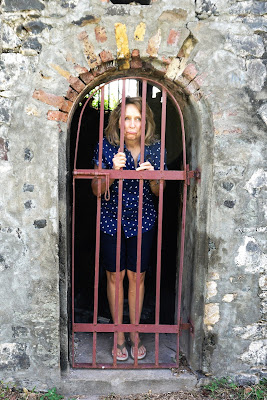The next stop on our Caribbean Cruise was the island of St. Lucia. Only 238 square miles, it is nevertheless a sovereign nation, as are many of the Caribbean islands. Originally invaded by the Dutch and the English, St. Lucia was officially claimed and then settled by the French in 1660, but then suffered through a couple centuries of fighting between the French and the British, during which time the island changed hands 14 times. It wasn't until 1979 that it became an independent commonwealth, though still associated with Great Britain.
In spite of its small size, this island was much harder to navigate than the others we had visited. As the map below shows, it is very mountainous, and the narrow roads snake up, down, and around those mountains in circuitous ways that didn't always make sense. I was glad that we had hired a private driver who knew where to go and how to get there.
Cool fact about St. Lucia: It is the ONLY country in the whole world named after a woman. St. Lucia (also known as St. Lucy) was a Christian woman who lived in Syracuse, Sicily, and was killed during the rule of the Roman Emperor Diocletian in 304 AD.
Another interesting fact about St. Lucia, and indeed about most of the Caribbean islands, is that the native people, called "Caribs," were replaced not by their conquerors, but by their conquerors' slaves. Other than Puerto Rico, every island we visited was populated predominantly by those of African descent.
We docked at Castries, the capital city, and met up with our driver, a native St. Lucian who has never ONCE left this little island. He was very nice, but he didn't offer any information unless we asked, and then his answers were only a few words spoken very quietly. It was a little frustrating.
The island is 40 miles long, and thus bigger than some of the other Caribbean Islands we had visited. However, distances seemed MUCH greater because of the convoluted roads. Our first stop was an overlook where the French used to have a military base. A guide waiting for us on the site (in whom I didn't have a lot of confidence) pointed out three tiny prison cells that he said were used to house 80-90 prisoners each:
He demonstrated what it was like for a prisoner, but I didn't think it was a fun as he did:























